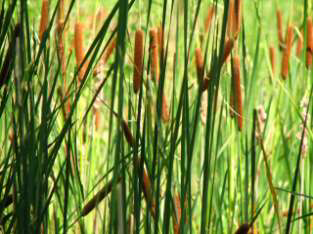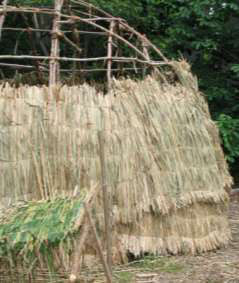 Narrow-leaved Cattail
Narrow-leaved Cattail
(Typha angustifolia)
|
Classification |
| Kingdom: |
Plantae |
| Division: |
Magnoliophyta |
| Class: |
Liliopsida |
| Order: |
Poales |
| Family: |
Typhaceae |
| Genus: |
Typha |
| Species: |
T. angustifolia |
 Characteristics: Narrow-leaved Cattail typically grows up 1 to 7 meters tall, with spongy, strap-like leaves and starchy, creeping stems. The jointless stem bears the flowers. The rhizomes spread horizontally beneath the surface of the ground to start new upright growth. The male flowers are reduced to a pair of stamens and hairs and wither once the pollen is shed, leaving a short and bare stem portion above the female inflorescence. The dense cluster of female flowers forms a cylindrical spike some 10 to as much as 40 centimeters long and 1 to 4 centimeters wide. The seeds are very small, only about 0.2 millimeters long. Cattails are monoecious, wind-pollinated, and bear unisex flowers developing in dense, complex spikes. The seeds are attached to a thin hair or stalk, which enhances wind dispersal.
Characteristics: Narrow-leaved Cattail typically grows up 1 to 7 meters tall, with spongy, strap-like leaves and starchy, creeping stems. The jointless stem bears the flowers. The rhizomes spread horizontally beneath the surface of the ground to start new upright growth. The male flowers are reduced to a pair of stamens and hairs and wither once the pollen is shed, leaving a short and bare stem portion above the female inflorescence. The dense cluster of female flowers forms a cylindrical spike some 10 to as much as 40 centimeters long and 1 to 4 centimeters wide. The seeds are very small, only about 0.2 millimeters long. Cattails are monoecious, wind-pollinated, and bear unisex flowers developing in dense, complex spikes. The seeds are attached to a thin hair or stalk, which enhances wind dispersal.
Habitat: Narrow-leaved Cattails grow in marshy areas.
Range: It can grow in temperate, subtropical and tropical areas throughout the Northern Hemisphere.
Native American Uses: Native American tribes used cattail down to line moccasins and papoose boards. The reeds of the Cattails were also cut down and woven together as mats to form covering for Native American shelters and making baskets, mats, rugs and bedding. The cattail was used as a urinary aid and to enhance kidney function. The rhizomes and the roots of the Narrow-leaved Cattail are a nutritious and energy-rich food source, generally harvested from late fall to early spring. In late spring, the bases of the leaves, while they are young and tender, can be eaten raw or cooked. As the flower spike is developing in early summer, it can be broken off and eaten, and in mid-Summer, once the flowers are mature, the pollen can be collected and used as a flour supplement or thickener. Iroquois and the Delaware Indians are among the Native American tribes that utilized this species.
Colonial Uses: The cattail down mixed with pigs grease was applied to burns. The down was also collected to make mattresses.